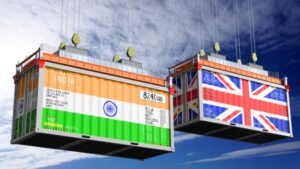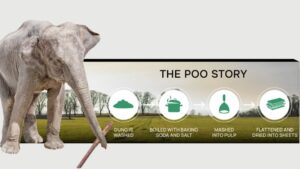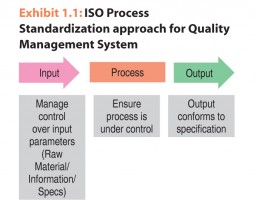
Competition from emerging sourcing destinations is forcing apparel exporters to expand to new markets and to explore cost saving opportunities. In such an environment, a comprehensive Quality Management System (QMS) can help manufacturers to standardize processes, adopt industry’s best practices, and improve straight through percentage (rework). To brace up to the challenge, apparel manufacturers are increasingly exploring QMS tools like TQM, ISO and Six Sigma Quality systems. It is observed that fire-fighting environment in apparel factory and slow adaption of best practices, make sustenance of Quality Management System difficult in the apparel industry. In the absence of knowledge on implementation methodology of these generic tools, many apparel exporters are unable to fathom the utility of these systems beyond a tool to attract international buyers. Team StitchWorld together having years of shop floor and consulting experience, deliberates implementation of ISO system in apparel industry. The article is the second of this series of articles describing QMS implementation in the needle trade.
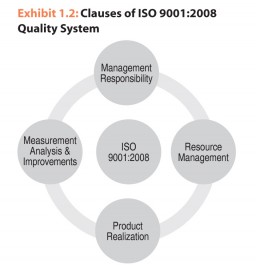
Unlike traditional quality control system that focuses on product standardization, ISO system lays emphasis on process standardization (refer Exhibit 1.1). The system stresses on documentation of process parameters (process KPIs), input indicators (fabric, trims, utility, manpower) and measurement and analysis parameters (audits and corrective/preventive actions) to enable improvements in manufacturing processes. It aims to bring process indicators (through process standardization) under control while exercising control on input indicators (raw material). The system targets a comprehensive Quality Management System by strengthening the four broad pillars of organizational process, indicated in Exhibit 1.2.
Since ISO standards are generic in nature, they can be implemented across all industries. Some of the popular ISO standards are illustrated in Exhibit 1.3.
| Exhibit 1.3: Various ISO standards | |
| ISO Code | Standards for |
| ISO 9000 | Quality Management System |
| ISO 14000 | Environmental Management |
| ISO 3166 | Country Codes |
| ISO 26000 | Social Responsibility |
| ISO 50001 | Energy Management |
| ISO 31000 | Risk Management |
| ISO 22000 | Food Safety Management |
| ISO 27001 | Information Security Managemet |
| ISO 45001 | Occupational Health and Safety |
Out of the various standards in ISO family, ISO 9000 lays down requirements and procedures for implementing Quality Management System (QMS), to which an apparel manufacturer must adhere to, for implementing a QMS based on the requirements of the 9000 systems. ISO 9001:2008 is the most recent standard of 9000 series, where ‘2008’ refers to the year of latest revision and 9001 indicates the title of a document (standard) that outlines the requirements an organization must maintain in their quality system for ISO 9001 certification. There are several documents in the ISO 9000 family of standards, but ISO 9001-2008 is the only ISO standard that can be certified (refer Exhibit 1.4).
| Exhibit 1.4: Documents in ISO 9000 family of standards | |
| ISO Code | Standards for |
| ISO 9001:2008 | Sets out the requirements of a Quality Management System |
| ISO 9000:2005 | Fundamentals and Vocabulary |
| ISO 9004:2009 | Focuses on how to make a Quality Management System more efficient and effective |
| ISO 19011:2011 | Focuses on how to make a Quality Management System more efficient and effective |
| ISO 19011:2011 | Sets out guidance on internal and external audits of Quality Management Systems |
Implementation
The system holistically identifies four parameters (refer Exhibit 1.2) called ‘clauses’, that together help in achieving improvement in organizational processes. A cross functional team should be instituted for performing diagnostic gap analysis of the existing documentation and measurement & analysis functions of the factory (both functions explained later). It has been observed that in many factories, a group of senior managers are usually entrusted with implementing the ISO system with little to no involvement of the lower management and operators in the design development and implementation process. This becomes a major stumbling block for sustaining the ISO system. In layman’s terms, implementing ISO system calls for an attitude of ‘do what you say and say what you do’. The system also calls for documentation of procedures, processes and practices, followed by audits of documentation and processes to bring business transformation. ISO implementation is based on compliance to procedures and processes of four pillars as described below.
| Exhibit 1.5: Documents in ISO 9000 family of standards | |
| Sr. No. | Document Type |
| 1. | Documented statements of policy and objectives |
| 2. | Quality manual |
| 3. | Document control procedure |
| 4. | Records control procedure |
| 5. | Internal audit procedure |
| 6. | Non-conforming product procedure |
| 7. | Corrective action procedure |
| 8. | Preventive action procedure |
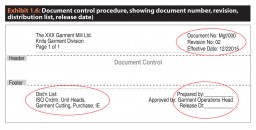
Pillar 1: Management Responsibility
First and the most important task of the top management is identifying and defining an appropriate quality policy for their business process. The top management should focus on approving the documentation and ensuring commitment of the team in implementing the policy. List of documents that need to be approved by the top management are enlisted in Exhibit 1.5. The measurement and analysis phase (described later), audits the conformance of documentation requirement in terms of Comments/ Evidence/Findings. Documents are audited to verify conformance to Current Revision, Storage Methodology (Electronic/Paper), Filing Authority, Retention Period and Disposition Method.
It is the responsibility of the top management to ensure adherence to policy documents. They should also ensure adherence to document control through review of documents (typically after every 12 months; refer Document control procedure, Exhibit 1.6).
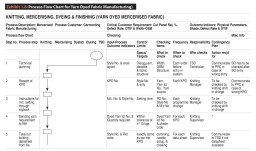
Pillar 2: Resource Management
ISO initiatives in human resource functions cover policies and procedures for HR activities. The documentation should define procedures and systems for staffing, job description, wages/salaries, KPI’s, appraisal system and skill development. Documentation also includes policy towards training manpower on ISO systems. Resource Management functions of HR in garment factory are:
1. Recruitment policy
2. Job description and work allocation
3. Appraisal policy
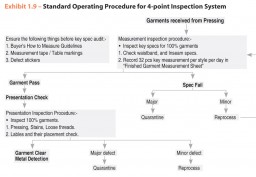
4. Incentive and payrole policy
5. Training and skill set requirement mapping policy
6. Skill development policy
7. Counselling
Pillar 3: Product Realization
The product realization pillar is aimed at standardizing quality and process through –
A. Exercising document control for all documents pertaining to finished garments
All documents should be legible and should facilitate identification of document revision. It is also important to exercise control over external documents, so as to harmonize them with internal documentation procedures like lab reports, subcontractor reports, challans, etc. Any revisions in external documents should be identified and approved before they get stacked in the records (meaning they should be traceable with internal tracking system ex. PO, Production Order, Lab Dip Report, etc.) Typically in garment operations, the documents that fall under the scope are:
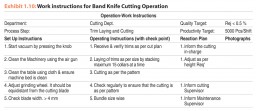
1. Material requisition report
2. Inspection and audit report (Fabric/Trims/Accessories/ Stores)
3. All internal and external dispatch and receipt reports
4. Purchase and sales orders
5. In-house and third-party test report
6. Pre-production meeting reports
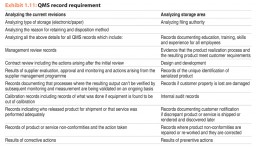
7. Sampling reports
8. Line plans and operation bulletins
9. Packing list 10. Audit reports
11. Re-screening report
12. Cut plans
13. Marker plans
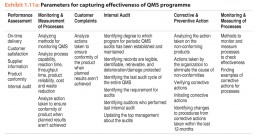
14. Size sets
15. Shrinkage and fabric test reports
16. Tech packs 17. Process flow charts
18. Scheduling report
19. Buyers samples and comments
20. Calibration records
21. Preventive and corrective action plans implemented against audit reports/customer complaints
B. Defining quality objective at each manufacturing stage
The process owners from fabric inspection to dispatch should define quality objectives for respective work areas (Fabric Inspection, Cutting-Sewing-Finishing). Depending on style and operation requirement, process owner should define quality requirements for each manufacturing stage. It is important to identify the component of the quality policy to which these quality objectives are tied, (refer Exhibit 1.7).
Exhibit 1.7: Example of Quality Objective defined for sewing floor
Quality Objectives for Sewing Floor
- Continuously improve garment sewing process efficiency
- Continuously reduce the sewing alteration rate
- Reduce our manufacturing costs by 5% per year
- Maintain a fair and creative work environment that respects new ideas and hard work
- Reduce cost of non-conforming materials (scrap and rework) by 15%
C. Defining product objectives
Defining product objective include defining routing and flow charts (refer Exhibit 1.8) based on product style. Process owner is responsible for documenting standard operating procedures (refer Exhibit 1.9). At job level, work instructions should define sequence of activities (refer Exhibit 1.10). It is important to identify the component of the quality policy to which process quality objectives are tied. It is necessary to implement this system even at sub-contact manufacturing.
The system focuses on four Pillars – Management Responsibility, Resource Management, Product Realization and Measurement Analysis & Improvement, to bring about organizational improvement.
D. Product development function
The product development function should document patterns, measurements, designs and all product-development related samples/records with revision and comments as per document control policy. Documentation should also include development stages, review of the designs, verification and validation for future reference. Results of gap analysis on product development samples with comments from buyer should be captured for process improvements.
Pillar 4: Measurement, Analysis and Improvement
This stage comprises of two parts, the first part deals with verification of policy documents in addition to documents enlisted at product analysis phase. The second part includes analysis of data regarding actual vs target performance to check the effectiveness of QMS program. The main parameters for verification of documents are enlisted in Exhibit 1.11.

The analysis part involves validating effectiveness of QMS program by checking actual vs. target shop floor performance by tracking documents pertaining to KPI and audit/customer compliant (refer Exhibit 1.11a & Exhibit 1.11b ). Some key performance parameters in garment manufacturing for analysis are:
- Dispatch performance (on time delivery)
- Customer complaints
- Audit pass rate (product conformity)
- Internal rejection rate
Conclusion
Implementing ISO QMS process in apparel manufacturing is based on four phases, namely Define, Document, Document Control, and Measurement & Analysis for bringing process improvements. It is observed that reliance on Documentation in the ISO system as compared to other QMS system like TQM/Six Sigma proves to be a hindrance in its successful implementation in needle trade.





